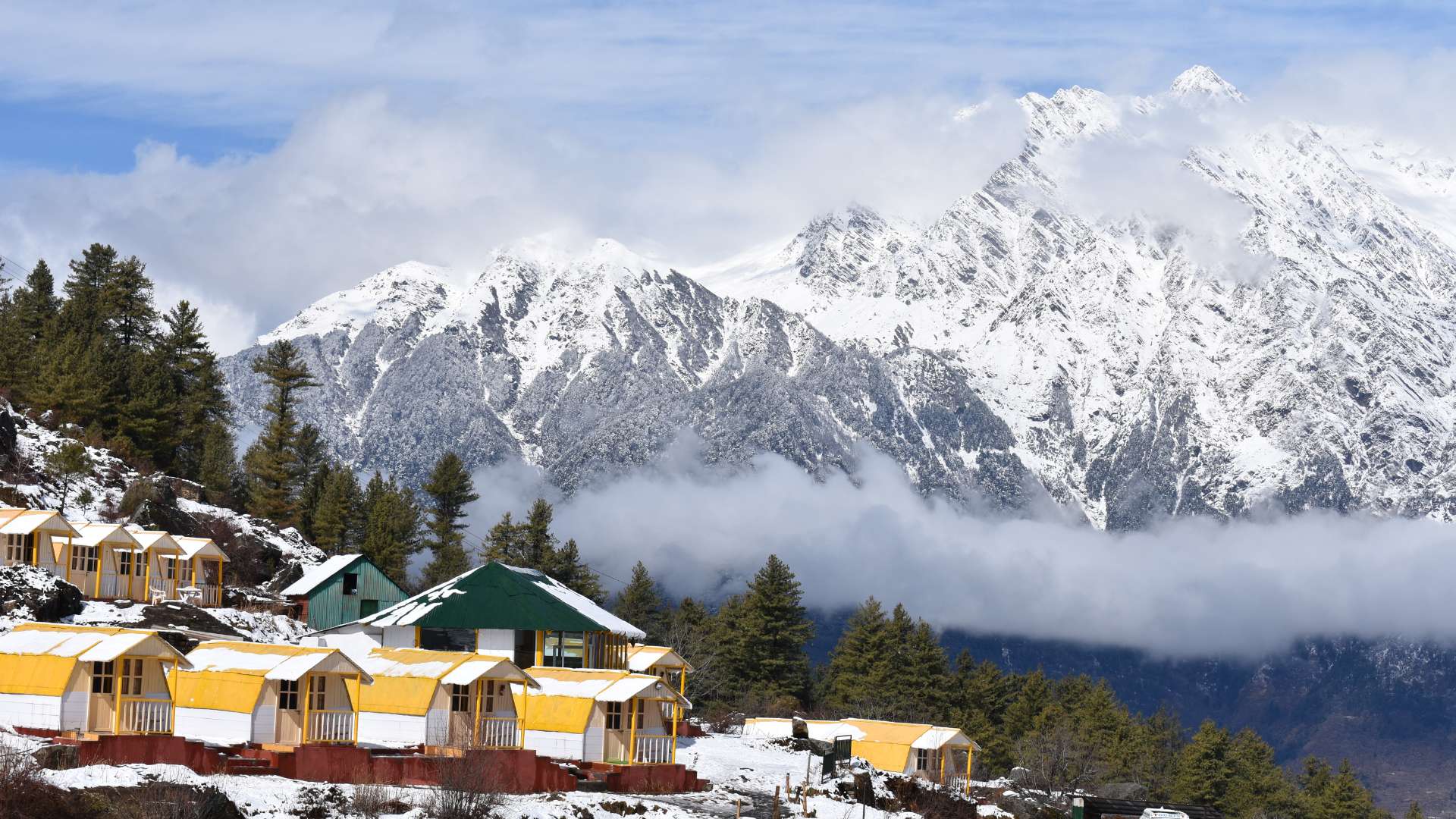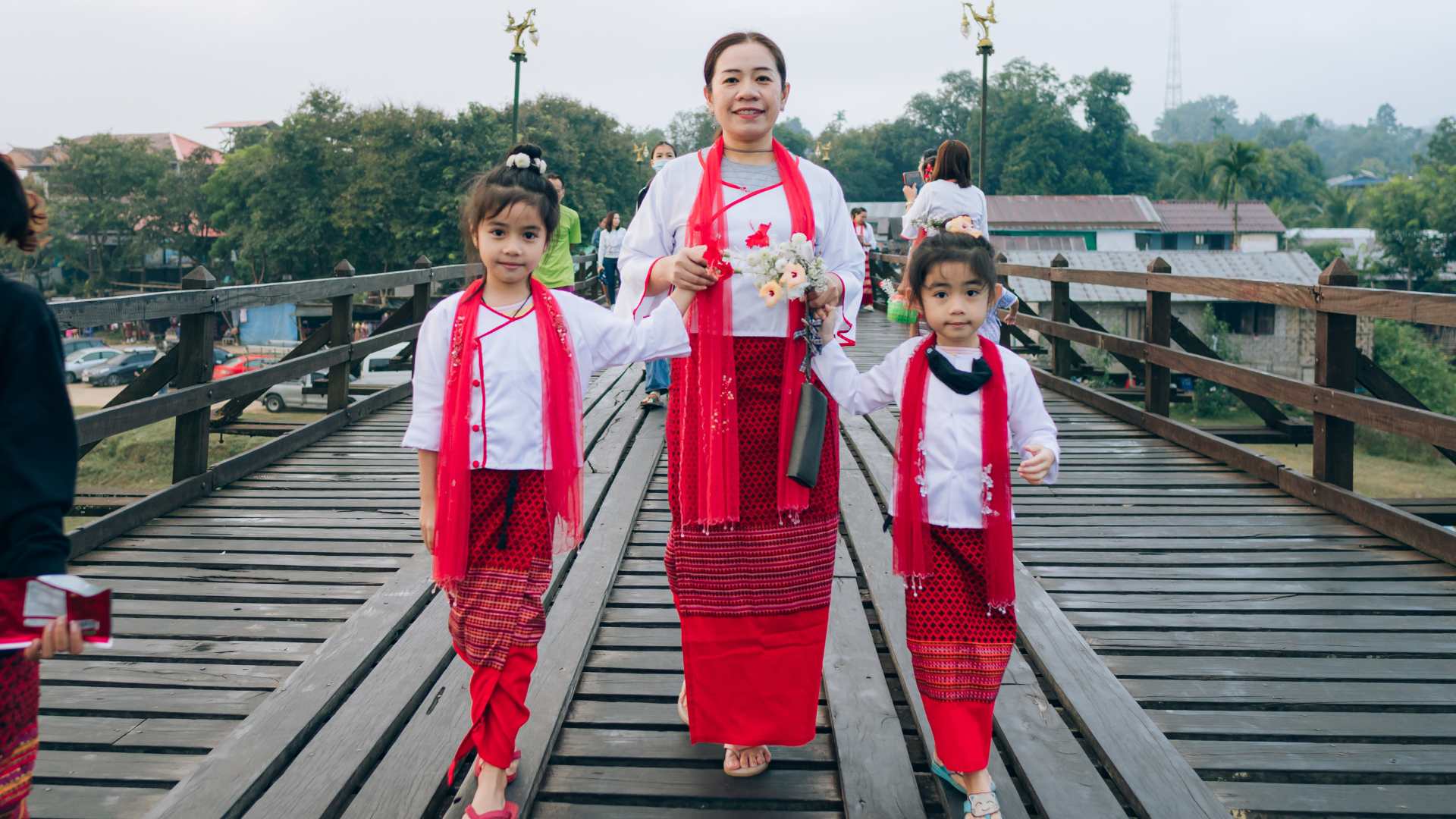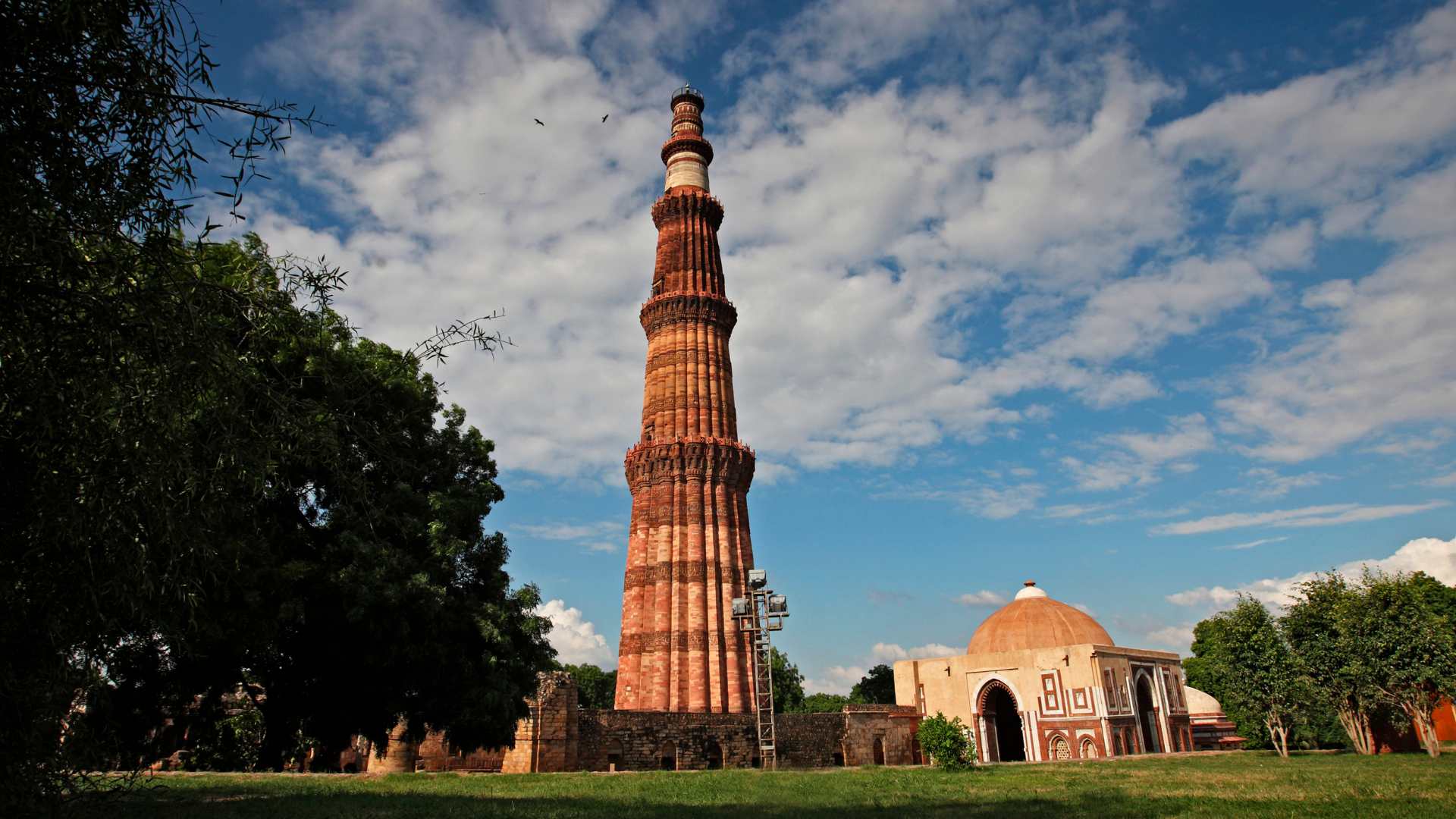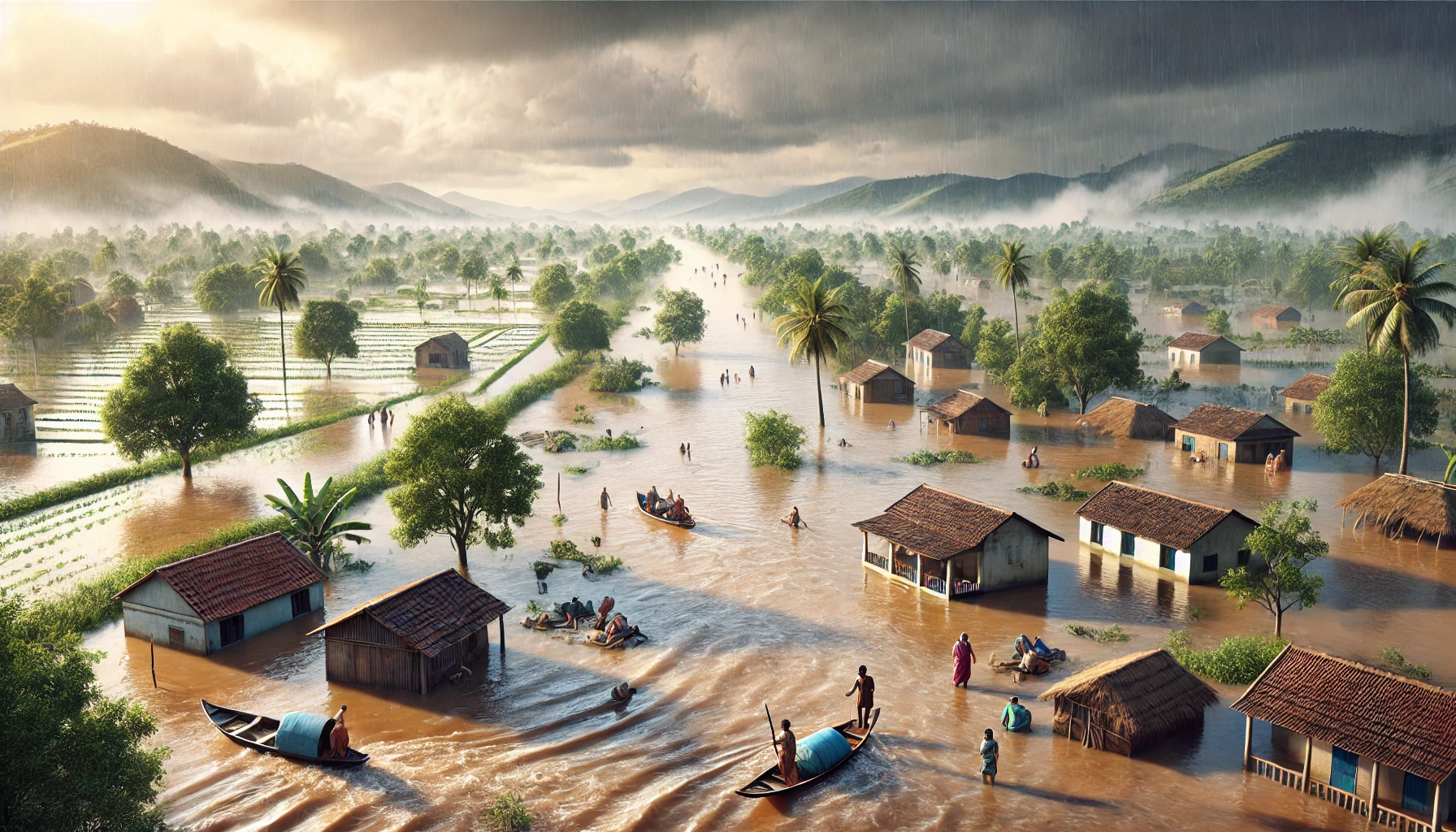Table of Contents
ToggleHimachal Pradesh, nestled in the lap of the Himalayas, is a region renowned not just for its stunning landscapes but also for its vibrant cultural heritage.
Among the most visible aspects of this heritage is the traditional attire worn by the people of the region.
The unique climate, geography, and diverse ethnic groups have led to the creation of distinct styles that vary from one district to another.
From intricately embroidered Cholis and Ghagras to the warm Pattu shawls and woolen Cholas, each garment tells the story of the region’s traditions, values, and artistic legacy.
This article delves into the Top 10 traditional dresses of Himachal Pradesh, highlighting the craftsmanship, cultural significance, and regional variations that make these garments unique.
Why is Traditional Clothing Important in Himachal Pradesh?
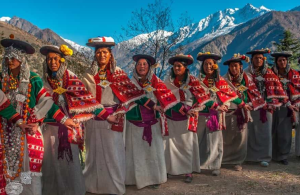
Image – Source
Traditional clothing in Himachal Pradesh goes beyond being just garments. These outfits represent the region’s cultural heritage, reflecting the distinct ethnic identities of its people.
The design, fabric, and embroidery of the clothes often carry symbolic meanings, representing the wearer’s social status, religion, or community.
In colder regions, woolen garments like the Pattu and Chola are essential for survival in the harsh climate.
Moreover, traditional clothing is crucial for maintaining connections with ancestral customs, particularly during festivals and ceremonies where these garments play a central role.
Preservation of these attires also helps to promote the local handloom industry, thus supporting the region’s economy and artisans.
What Materials Are Used in Himachali Traditional Attire?
Himachali traditional attire largely utilizes natural, locally sourced materials. Wool is the most commonly used fabric, particularly in regions like Kullu, Kinnaur, and Lahaul, where winters are long and harsh.
Woolen garments such as Pattu, Chola, and Dorukha shawls offer warmth and durability.
Cotton is another widely used material, especially in summer versions of clothing like Churidar Pajamas or lighter variations of Choli and Ghagra.
Silk, often reserved for special occasions, is used in more decorative clothing, such as the Chamba Chaugoshi, known for its intricate embroidery.
These materials not only provide protection from the environment but also maintain the cultural richness of Himachal Pradesh’s dressing style.
How Do Festivals and Ceremonies Influence Traditional Dress in Himachal Pradesh?
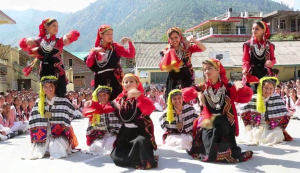
Festivals and ceremonies are significant in Himachal Pradesh, and traditional attire plays a vital role during these occasions.
The Kullu Dussehra, a famous regional festival, sees both men and women dressed in vibrant, handwoven Pattu shawls, embroidered Kurtas, and Ghagras.
Weddings, religious ceremonies, and local celebrations like Phulaich are other occasions where the locals showcase their finest traditional garments.
These events often feature clothing made from luxurious materials like silk or pashmina, adorned with elaborate embroidery.
The cultural significance of these garments during festivals serves not only as a mark of respect but also as a way to keep traditions alive through generations.
How Have Modern Trends Impacted Himachali Traditional Clothing?
While traditional garments are still central to festivals and religious occasions, modern trends have influenced everyday wear in Himachal Pradesh.
The shift towards lighter, more comfortable fabrics like cotton and synthetic blends is noticeable in urban areas, particularly in summer clothing.
Contemporary adaptations of traditional garments, such as simplified versions of the Ghagra-Choli or Churidar Pajama, have also emerged, blending modern aesthetics with traditional elements.
However, in rural regions and during festivals, traditional woolen clothing such as the Kulluvi Kurta or Pattu remains popular.
This balance between modern convenience and traditional preservation helps keep the cultural identity intact while allowing for practical adjustments in everyday fashion.
What Role Do Local Artisans Play in Preserving Himachali Traditional Dress?
Local artisans are the backbone of Himachal Pradesh’s traditional textile industry. Many of these garments, particularly woolen items like Pattu shawls and Kinnauri Cholas, are handwoven using skills passed down through generations.
Artisans in regions such as Kullu and Kinnaur are known for their intricate weaving and embroidery techniques, often incorporating nature-inspired patterns into their work.
Efforts to preserve these traditional crafts include organizing festivals, cultural programs, and government-backed initiatives that support the handloom industry.
By promoting these local crafts, artisans play a crucial role in maintaining the region’s cultural identity and providing sustainable livelihoods for their communities.
What Are the Regional Variations in Himachali Traditional Attire?
Himachal Pradesh’s diverse geography and climate have resulted in significant regional variations in traditional attire.
In the colder regions of Lahaul and Spiti, heavy woolen garments like the Chola and Ghagri-Chaddar are prevalent, providing insulation against harsh winters.
In Kinnaur, intricate Pattu shawls and Kinnauri topis are worn, often featuring elaborate embroidery.
In contrast, Chamba is known for the vibrant Chamba Chaugoshi, a decorative dress marked by colorful threadwork.
These regional differences in design, fabric, and craftsmanship reflect the unique cultures and traditions of each area, contributing to the rich textile heritage of Himachal Pradesh.
Top 10 Traditional Dress of Himachal Pradesh
1. Choli and Ghagra
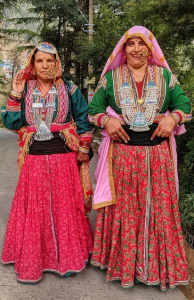
Image – Source
The Choli and Ghagra are among the most well-known traditional dresses for women in Himachal Pradesh.
The choli, a fitted blouse, and the ghagra, a long pleated skirt, are paired together to form this vibrant outfit.
The choli is often intricately embroidered, reflecting the region’s artistic flair. These garments are especially popular during festivals and cultural events, where women often pair them with a colorful woolen dupatta.
These dresses not only showcase the colorful traditions of the region but are also practical for the cold climate, especially in higher altitudes.
Woolen fabrics are often used for these garments, making them ideal for winter months. The Choli and Ghagra are symbolic of Himachali women’s strong connection to their culture and heritage.
Choli and Ghagra Dress Details
| Dress Features | Details |
| Dress Name | Ghagra-Choli (Female) |
| Cultural Significance | Worn by women during festivals, religious ceremonies, and other special occasions. |
| Fabric & Textiles | Wool, pashmina, and cotton with handwoven designs. |
| Design Features | Full-length pleated skirt, fitted blouse, paired with a colorful woolen dupatta. |
| Color Palette | Vibrant shades of red, green, blue with contrasting embroidery. Earthy tones for casual wear. |
| Wearing Style | Ghagra is worn around the waist with pleats; Choli is fitted. Dupatta draped over the shoulders. |
| Occasions for Use | Commonly seen at festivals like Kullu Dussehra and in weddings. |
| Accessories | Silver jewelry like anklets, bangles, and traditional headgear such as Dhatu or Rumaal. |
| Craftsmanship | Notable for its intricate hand embroidery and wool weaving by local artisans. |
| Cultural Importance | Reflects the lifestyle and heritage of rural Himachal Pradesh. |
| Modern Variations | Incorporates lighter fabrics like cotton, with modern designs keeping traditional elements intact. |
| Seasonal Adaptation | Woolen fabrics for winter, cotton for summer. |
| Headgear and Shawls | Often paired with Himachali Topi and woolen shawls like Pattu. |
| Pattern and Embroidery | Embroidery inspired by local flora, featuring motifs like flowers and vines. |
| Influence of Local Tribes | Influences from Gaddi, Kinnauri, and Lahauli communities. |
2. Pattu (Kinnauri)
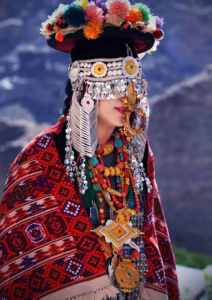
Image – Source
The Pattu is a woolen shawl or draped dress, traditionally worn by women in the Kinnaur region of Himachal Pradesh.
It is highly popular due to its intricate weaving and the warmth it provides. Pattu is made from locally sourced wool and is known for its geometric patterns and vibrant colors, especially reds and blues.
The pattu is secured with a brooch or pin at the shoulder, and it covers the body, offering protection against the cold.
Worn daily or during cultural ceremonies, the Pattu is a symbol of the deep-rooted textile traditions of Kinnaur.
It is both a practical garment and an important cultural artifact, representing the weaving skills passed down through generations.
Pattu Dress Details
| Dress Features | Details |
| Dress Name | Pattu (Kinnauri) |
| Cultural Significance | Worn by women during festivals, religious ceremonies, and daily use in cold regions. |
| Fabric & Textiles | Made from local wool, featuring intricate geometric patterns. |
| Design Features | Worn as a shawl or draped dress, fastened with a brooch. |
| Color Palette | Dominated by vibrant reds and blues, with detailed weaves in contrasting shades. |
| Wearing Style | Draped around the body and secured at the shoulder. |
| Occasions for Use | Used in cultural events, and everyday wear in the Kinnaur region. |
| Accessories | Often paired with silver ornaments and brooches to secure the shawl. |
| Craftsmanship | Known for its handwoven patterns, which are made by local artisans. |
| Cultural Importance | Reflects Kinnaur’s textile heritage and cold-weather adaptation. |
| Modern Variations | Contemporary versions use lighter fabrics for warmer climates. |
| Seasonal Adaptation | Primarily a winter garment due to its thick woolen fabric. |
| Headgear and Shawls | Paired with traditional Kinnauri headgear and smaller shawls. |
| Pattern and Embroidery | Complex patterns with regional variations in weaving styles. |
| Influence of Local Tribes | Strong influence from Kinnauri artisans and local weaving traditions. |
3. Chamba Chaugoshi
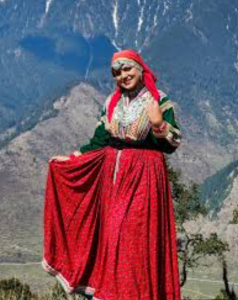
Image – Source
The Chamba Chaugoshi is a distinctive traditional dress from the Chamba district of Himachal Pradesh.
This outfit stands out due to its vibrant embroidery work, which uses multi-colored threads to create intricate designs on the fabric.
The Chaugoshi typically consists of a long dress, paired with a matching dupatta, making it both graceful and functional.
Worn during festivals, the Chaugoshi is a reflection of Chamba’s rich artistic traditions, where artisans painstakingly craft the unique motifs and designs.
The style has been preserved for generations and remains a cultural pride of Chamba’s local community.
Chamba Chaugoshi Dress Details
| Dress Features | Details |
| Dress Name | Chamba Chaugoshi (Female) |
| Cultural Significance | Celebrated for its unique embroidery, worn during festivals and weddings. |
| Fabric & Textiles | Made from cotton or wool, featuring vibrant, multi-colored embroidery. |
| Design Features | A long dress paired with a dupatta, known for its intricate designs. |
| Color Palette | Bright hues such as red, orange, and blue, with contrasting thread work. |
| Wearing Style | Full-length dress with dupatta draped over the head or shoulders. |
| Occasions for Use | Typically worn during festivals like Minjar and weddings. |
| Accessories | Paired with traditional silver jewelry and head coverings like the Dhatu. |
| Craftsmanship | Renowned for its elaborate hand-embroidered motifs, often created by skilled artisans. |
| Cultural Importance | Reflects Chamba’s local identity and artistic heritage. |
| Modern Variations | Lighter, modern fabrics with simpler designs for everyday wear. |
| Seasonal Adaptation | Woolen versions are common in winter; cotton versions for summer. |
| Headgear and Shawls | Typically paired with woolen shawls and traditional Chamba headgear. |
| Pattern and Embroidery | Known for detailed floral and geometric embroidery. |
| Influence of Local Tribes | Influenced by Chamba’s rich tradition of embroidery and weaving. |
4. Reshta
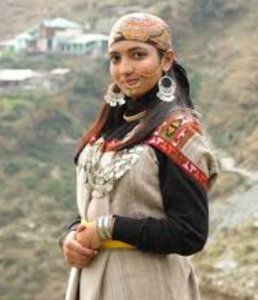
Image – Source
The Reshta is a traditional long, flowing dress, commonly worn by women in the Kullu region of Himachal Pradesh.
Like other Himachali dresses, the Reshta is typically paired with a dupatta and woven from wool or cotton, depending on the season.
It provides warmth and protection from the cold and is a popular choice in higher altitudes.
Besides its practical benefits, the Reshta symbolises elegance in rural Himachali life. It is worn daily or on special occasions, showcasing intricate local designs that reflect the artistry of the Kullu region.
Reshta Dress Details
| Dress Features | Details |
| Dress Name | Reshta (Female) |
| Cultural Significance | A symbol of elegance and simplicity, worn in daily life and festivals. |
| Fabric & Textiles | Made from wool or cotton, often handwoven by local artisans. |
| Design Features | Flowing dress with simple, yet elegant patterns; paired with a dupatta. |
| Color Palette | Pastel shades for daily use; brighter colors for festive occasions. |
| Wearing Style | Draped and secured with a belt or brooch, covering most of the body. |
| Occasions for Use | Commonly worn during festivals, religious gatherings, and daily life in colder regions. |
| Accessories | Paired with silver jewelry like necklaces, and head coverings such as Dhatu. |
| Craftsmanship | Focus on simplicity, with detailed handwoven patterns. |
| Cultural Importance | Reflects the lifestyle and customs of rural Himachal communities. |
| Modern Variations | Lighter, modern versions with contemporary patterns are available for casual wear. |
| Seasonal Adaptation | Woolen fabrics for cold weather; lighter cotton versions for summer. |
| Headgear and Shawls | Often paired with woolen shawls and headgear like the Himachali Topi. |
| Pattern and Embroidery | Typically minimalistic, with subtle embroidery. |
| Influence of Local Tribes | Influenced by local Kullu traditions and craftsmanship. |
5. Kulluvi Kurta
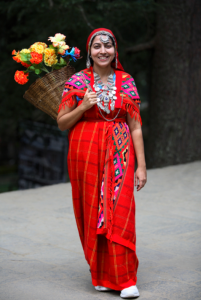
Image – Source
The Kulluvi Kurta is a long, woolen kurta traditionally worn by men in the Kullu Valley. Known for its warmth and durability, it is a practical garment for the region’s cold climate.
The kurta is usually paired with churidar or pajama pants, which makes it comfortable for movement through mountainous terrain.
This traditional garment is often embroidered with intricate patterns along the neckline and sleeves, reflecting Kullu’s artistic heritage.
It is especially worn during festivals and cultural events, highlighting the connection between clothing and cultural identity in Himachal Pradesh.
Kulluvi Kurta Dress details
| Dress Features | Details |
| Dress Name | Kulluvi Kurta (Male) |
| Cultural Significance | Worn during festivals and cultural events, symbolizing local heritage. |
| Fabric & Textiles | Made from wool or cotton, often featuring embroidery around the neck and sleeves. |
| Design Features | Long kurta with full sleeves, embroidered patterns. |
| Color Palette | Neutral shades like white, grey, and brown, with colorful embroidery accents. |
| Wearing Style | Paired with churidar or pajama; worn loose for comfort and mobility. |
| Occasions for Use | Worn during Kullu Dussehra, weddings, and other cultural festivals. |
| Accessories | Paired with traditional Himachali Topi and silver jewelry. |
| Craftsmanship | Known for its intricate hand-embroidery, practiced by local artisans. |
| Cultural Importance | Represents the cultural identity of Kullu and its weaving traditions. |
| Modern Variations | Lighter versions with simpler designs are worn casually. |
| Seasonal Adaptation | Woolen versions for winter; cotton for summer wear. |
| Headgear and Shawls | Often worn with Himachali Topi and a woolen shawl or Chaddar. |
| Pattern and Embroidery | Traditional embroidery patterns, often inspired by nature. |
| Influence of Local Tribes | Influenced by Kullu’s tribal communities and their traditional weaving techniques. |
6. Chola (Men)

Image – Source
The Chola is a long woolen coat traditionally worn by men in the colder regions of Himachal Pradesh, particularly in areas like Lahaul and Spiti.
This garment serves as a protective layer against the cold and is often worn over a kurta or other inner garments.
The Chola’s design is simple yet functional, made from thick wool to provide warmth in the harsh mountain climate.
Worn primarily for daily tasks or during festivals, the Chola is an essential part of the traditional men’s wardrobe in Himachal Pradesh.
It is a symbol of the region’s practical approach to clothing, blending function with cultural significance.
Chola Dress Details
| Dress Features | Details |
| Dress Name | Chola (Male) |
| Cultural Significance | A traditional woolen coat, symbolizing the practicality of Himachali men’s clothing. |
| Fabric & Textiles | Made from thick wool, designed to protect against cold weather. |
| Design Features | Long coat with full sleeves, minimal embroidery. |
| Color Palette | Neutral tones like grey, brown, and black to blend with the natural surroundings. |
| Wearing Style | Worn over a kurta or inner garments, often belted at the waist. |
| Occasions for Use | Worn daily for protection against the cold; also used during festivals and gatherings. |
| Accessories | Paired with headgear such as Himachali Topi and a woolen shawl. |
| Craftsmanship | Typically handwoven, with emphasis on warmth and durability. |
| Cultural Importance | Represents the simplicity and functionality of Himachali men’s traditional attire. |
| Modern Variations | Contemporary versions may include lighter fabrics for casual wear. |
| Seasonal Adaptation | Primarily worn in winter due to its woolen fabric. |
| Headgear and Shawls | Often paired with a traditional shawl or Chaddar and Himachali Topi. |
| Pattern and Embroidery | Minimal embroidery, focusing on functionality over decoration. |
| Influence of Local Tribes | Inspired by local communities in Lahaul and Spiti, where warmth is essential. |
7. Suthan (Pahari Salwar)
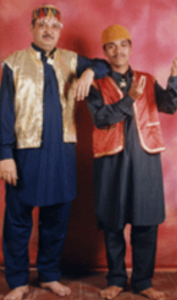
Image – Source
The Suthan is a traditional pair of loose pants worn by men in Himachal Pradesh, particularly in the Pahari regions.
Similar to salwar, the Suthan is comfortable and practical for the state’s hilly terrain. It is often paired with a long shirt or kurta and provides easy movement, making it ideal for daily wear and agricultural work.
The Suthan has remained a staple in traditional men’s clothing, reflecting the region’s need for practical and functional attire.
It is often worn with minimal decoration but provides comfort and flexibility for those living in mountainous regions.
Suthan Dress Details
| Dress Features | Details |
| Dress Name | Suthan (Male) |
| Cultural Significance | Practical, loose-fitting pants worn by men for daily work and festivals. |
| Fabric & Textiles | Made from wool or cotton, depending on the season. |
| Design Features | Loose-fitting with a tapered bottom for comfort and ease of movement. |
| Color Palette | Neutral shades like brown, black, or white. |
| Wearing Style | Paired with a kurta, belted at the waist for a comfortable fit. |
| Occasions for Use | Worn daily, especially by those working in agriculture or outdoor tasks. |
| Accessories | Often paired with traditional headgear or a shawl. |
| Craftsmanship | Simple design with focus on comfort and functionality. |
| Cultural Importance | Reflects the lifestyle of rural men in Himachal, blending tradition with practical needs. |
| Modern Variations | Casual versions include lighter materials for summer wear. |
| Seasonal Adaptation | Woolen for winter, cotton for summer. |
| Headgear and Shawls | Often paired with Himachali Topi or a woolen shawl. |
| Pattern and Embroidery | Minimal decoration, focusing on practicality. |
| Influence of Local Tribes | Common among Pahari communities, with influences from local work attire. |
8. Topi and Pagri
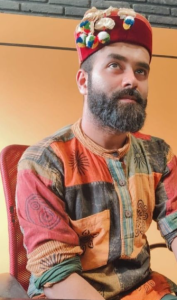
Image – Source
The Topi (cap) and Pagri (turban) are significant traditional headgear worn by men in Himachal Pradesh. They symbolize respect and cultural pride.
The Himachali Topi, particularly from the Kullu region, is a flat-brimmed wool cap often decorated with intricate embroidery or a band of colorful cloth known as Pattu.
It is worn during everyday activities and special occasions like weddings and religious ceremonies.
On the other hand, the Pagri is a more elaborate headgear, typically reserved for ceremonial purposes.
It is a long piece of cloth wrapped around the head in a specific style, reflecting honour and status in the community. Headgear represents the cultural identity of Himachali men and is integral to their traditional attire.
Topi and Pagri Dress Details
| Dress Features | Details |
| Dress Name | Topi and Pagri (Male) |
| Cultural Significance | Symbol of respect, honor, and cultural pride, worn during festivals and ceremonies. |
| Fabric & Textiles | Made from wool or cotton; Topi is often embroidered, while the Pagri is a long cloth wrap. |
| Design Features | Flat-brimmed cap (Topi) with colorful Pattu; Pagri is wrapped elegantly around the head. |
| Color Palette | Topi features neutral shades with colorful bands; Pagri is often in vibrant colors for ceremonies. |
| Wearing Style | Topi is worn daily; Pagri is wrapped during special occasions. |
| Occasions for Use | Festivals like Kullu Dussehra, weddings, and formal events. |
| Accessories | Often paired with traditional woolen shawls or Chaddar. |
| Craftsmanship | Handwoven with local wool, showcasing regional craftsmanship. |
| Cultural Importance | Reflects Himachali men’s honor and their connection to local traditions. |
| Modern Variations | Contemporary versions include simpler designs for casual wear. |
| Seasonal Adaptation | Woolen versions for colder months; lighter fabrics for summer. |
| Headgear and Shawls | Always paired with a shawl or Chaddar for added warmth and style. |
| Pattern and Embroidery | Topi often features intricate floral or geometric embroidery. |
| Influence of Local Tribes | Common among Kullu and other Himachali tribes, symbolizing regional identity. |
9. Ghagri and Chaddar
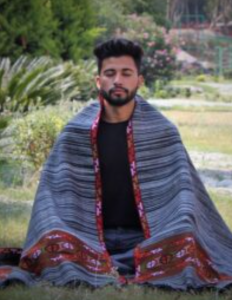
Image – Source
The Ghagri and Chaddar are another popular combination of traditional garments worn by women in Himachal Pradesh.
The Ghagri is a long, flowing skirt, typically pleated and worn with a blouse.
It is often paired with the Chaddar, an oversized shawl draped over the shoulders and head, serving as both an accessory and a layer of warmth in the chilly mountainous regions.
This outfit is most commonly seen in the Lahaul and Spiti regions, where the cold climate demands warm, woolen fabrics.
The Ghagri and Chaddar ensemble reflects the simple yet functional approach to traditional dressing, rooted in the region’s culture and daily life.
Ghagri and Chaddar Dress Details
| Dress Features | Details |
| Dress Name | Ghagri and Chaddar (Female) |
| Cultural Significance | Worn daily and during local festivals, symbolizing cultural traditions in cold regions. |
| Fabric & Textiles | Woolen fabric for warmth, often featuring handwoven designs. |
| Design Features | Full-length pleated skirt (Ghagri) paired with a large woolen shawl (Chaddar). |
| Color Palette | Subtle shades like grey, brown, and dark green, with hints of embroidery. |
| Wearing Style | Ghagri is worn at the waist with pleats, Chaddar is draped over the head and shoulders. |
| Occasions for Use | Worn during religious gatherings, festivals, and daily life in colder regions like Lahaul. |
| Accessories | Paired with silver jewelry and traditional headgear. |
| Craftsmanship | Handwoven by local artisans, known for their durable designs. |
| Cultural Importance | Reflects the lifestyle and traditions of the women in Lahaul and Spiti. |
| Modern Variations | Lighter fabrics are now used in warmer areas, though the traditional style remains. |
| Seasonal Adaptation | Woolen versions are worn in winter; cotton versions are used in summer. |
| Headgear and Shawls | Paired with woolen shawls or headscarves to protect against the cold. |
| Pattern and Embroidery | Minimal patterns with subtle floral embroidery. |
| Influence of Local Tribes | Reflects the weaving traditions of local tribal communities in Himachal Pradesh. |
10. Pattu (Men’s version)
The Pattu, primarily a woolen garment, also has a version for men in Himachal Pradesh. Worn as a thick shawl, the men’s Pattu provides warmth in the cold climates of regions like Kinnaur and Kullu.
Made from handwoven wool, it features intricate geometric patterns and bold stripes, reflecting the artistry of local weavers.
The Pattu is draped around the shoulders and can be secured with a brooch or simply left to hang for insulation.
Men wear the Pattu during daily tasks or festivals, especially in winter, as a practical and cultural garment.
It is not only functional but also embodies the traditional craftsmanship passed down through generations of Himachali artisans.
Pattu Dress Details
| Dress Features | Details |
| Dress Name | Pattu (Men’s) |
| Cultural Significance | Worn daily and during festivals, providing warmth and showcasing traditional craftsmanship. |
| Fabric & Textiles | Handwoven from wool, designed to be thick and warm. |
| Design Features | A large rectangular shawl with intricate geometric patterns and stripes. |
| Color Palette | Typically neutral shades like brown, grey, or black, with vibrant accents. |
| Wearing Style | Draped over the shoulders, often secured with a pin or brooch. |
| Occasions for Use | Worn daily, especially in colder months and during festivals like Kullu Dussehra. |
| Accessories | Paired with traditional Himachali Topi or Pagri and silver jewelry. |
| Craftsmanship | Handwoven by local artisans, focusing on intricate patterns and durable fabric. |
| Cultural Importance | Reflects the lifestyle and traditions of men in high-altitude regions like Kinnaur and Kullu. |
| Modern Variations | Contemporary versions incorporate lighter materials for casual wear. |
| Seasonal Adaptation | Primarily a winter garment due to its thick woolen fabric. |
| Headgear and Shawls | Worn with a traditional cap or turban, often paired with a woolen shawl. |
| Pattern and Embroidery | Features geometric patterns inspired by local landscapes. |
| Influence of Local Tribes | Influenced by the Gaddi and Kinnauri weaving traditions, which reflect their cultural heritage, |
Conclusion
The traditional attire of Himachal Pradesh is a testament to the region’s rich cultural tapestry.
Each garment, whether it’s the embroidered Chamba Chaugoshi, the durable Chola, or the vibrant Ghagra and Chaddar, reflects the heritage, craftsmanship, and way of life of the people in this mountainous region.
More than just clothing, these outfits symbolize identity and pride, connecting the people to their ancestral roots while providing practical solutions to the region’s harsh climate.
As modern fashion continues to evolve, efforts to preserve and celebrate these traditional dresses are crucial for keeping Himachal Pradesh’s cultural legacy alive for future generations.
FAQs About Traditional Dress of Himachal Pradesh
What is the most common fabric used in Himachali traditional clothing?
Wool is the most common fabric, especially in colder regions, for garments like Pattu shawls and Cholas.
What is the significance of the Himachali Topi?
The Himachali Topi symbolizes respect and cultural pride, worn during festivals and important occasions.
Are traditional Himachali dresses still worn today?
Yes, especially during festivals, weddings, and cultural events, though modern versions are becoming more common.
What is the difference between Pattu and Chaddar?
The Pattu is a thicker woolen garment, while the Chaddar is a lighter shawl, both worn for warmth and style.
Which region is known for the Chamba Chaugoshi?
The Chamba district is famous for the Chamba Chaugoshi, known for its intricate multi-colored embroidery.
How have modern trends influenced Himachali attire?
Modern trends have introduced lighter fabrics and contemporary designs, though traditional garments remain popular for cultural events.
Why is embroidery important in Himachali clothing?
Embroidery reflects regional identity and artistic heritage, often showcasing nature-inspired motifs in traditional garments.


